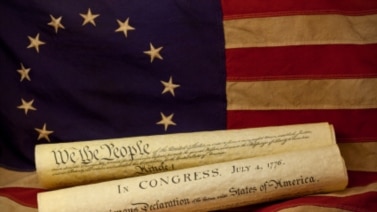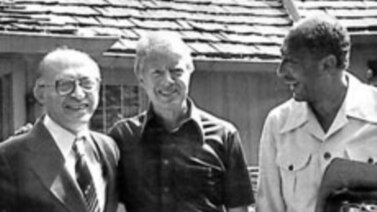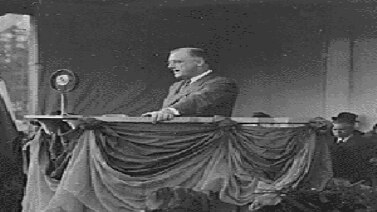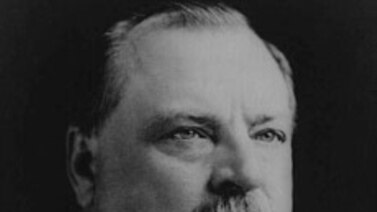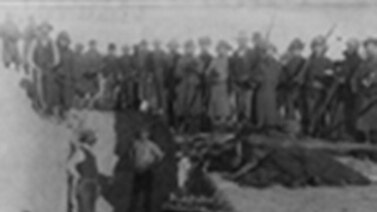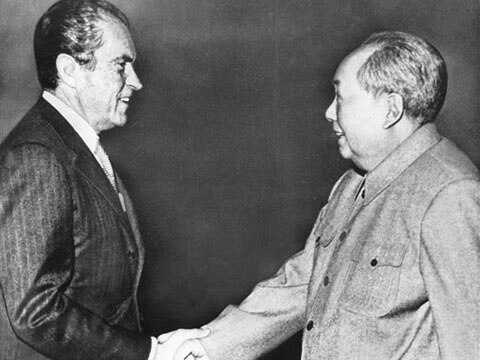
STEVE EMBER: Welcome to THE MAKING OF A NATION -- American history in VOA Special English. I'm Steve Ember.
Today, we continue the story of the thirty-seventh president of the United States, Richard Nixon.
(MUSIC)
The year is nineteen sixty-nine. Richard Nixon, a Republican, is in the first year of his first term in office. His biggest foreign policy problem is the continuing war in Vietnam. During the election campaign, Nixon had promised to do something to end the war.
The question was: what?
Some Americans want him to withdraw troops from Vietnam immediately. Bring the soldiers home, they say. Others believe the United States should take whatever measures are necessary to win. Expand the ground war, they say, or even use nuclear weapons.
Withdrawing troops would leave South Vietnam alone to resist communist North Vietnam. Yet that was the reason the United States had entered the conflict -- to prevent the communists from capturing the south.
Expanding the war would not be an easy decision either. Already, by nineteen sixty-nine, more Americans had died in Vietnam than had died during the Korean War.
For Richard Nixon, the war is a terrible test. If he fails, his presidency could end the way Lyndon Johnson's presidency ended. Johnson decided not to run for re-election after he lost public and political support for his war policies.
Presidents have advisers, and Nixon's most important adviser was Henry Kissinger. Kissinger was an expert on foreign relations. He later served as Nixon's secretary of state. Together, they tried many ways to settle the conflict in Vietnam. It took several years before the involvement of the United States would finally end.
The American efforts were both diplomatic and military. Peace talks were taking place in Paris. But the Nixon administration started secret peace talks in Paris at the same time. The administration also withdrew some troops from Vietnam. Yet -- secretly -- it sent other troops into Cambodia. And it began bombing Laos.
(SOUND)
The Nixon administration also started bombing North Vietnam again. Lyndon Johnson had stopped the raids a few years earlier.
(MUSIC)
Efforts to end American involvement in Vietnam did not begin immediately. For his first eight months in office, President Nixon made no major policy changes. Then, in October nineteen sixty-nine, he ordered the withdrawal of sixty thousand troops.
He said he acted to speed the peace talks. He also ordered American commanders to give the South Vietnamese most of the responsibility for fighting.
Americans were happy that fewer troops would be involved. But many were unhappy that the withdrawal was not complete. Huge anti-war demonstrations took place in the United States in the autumn of nineteen sixty-nine. On November fifteenth, several hundred thousand people protested in Washington.
Nixon tried to explain to the American people why he was not ordering an immediate withdrawal. In his words: "It is not the easy way. It is the right way.”
In the spring of nineteen seventy, American and South Vietnamese troops invaded Cambodia.
RICHARD NIXON: "Tonight, American and South Vietnamese units will attack the headquarters for the entire communist military operation in South Vietnam.”
Nixon described to the American public why he had decided to order the actions in Cambodia.
NIXON: “This key control center has been occupied by the North Vietnamese and Viet Cong for five years, in blatant violation of Cambodia’s neutrality. This is not an invasion of Cambodia. The areas in which these attacks will be launched are completely occupied and controlled by North Vietnamese forces. Once enemy forces are driven out of these sanctuaries, and once their military supplies are destroyed, we will withdraw.”
(MUSIC)
Early in nineteen seventy-one, the Nixon administration decided to provide air and artillery support for a South Vietnamese invasion of Laos. The goal was to stop supplies from reaching North Vietnam through that neighboring country.
South Vietnamese forces destroyed many enemy weapons. But they also suffered heavy losses, and many American planes were shot down. After six weeks, the South Vietnamese were forced to withdraw.
Many members of the United States Congress were angry. They said the invasion of Laos was another in a long series of failures. Nixon's administration had said the United States was winning the war. Opposition Democrats in Congress said the administration was lying. Criticism by the American public grew louder, as well.
Demonstrations took place across the country, including on college campuses.
(SOUND)
On May fourth, nineteen seventy, National Guard troops shot and killed four students during protests at Kent State University in Ohio.
This is what Neil Young means when he sings of "four dead in Ohio" in a famous protest song that he wrote in reaction to the killings.
(MUSIC: "Ohio"/Crosby, Stills, Nash and Young)
President Nixon said again that the United States must not permit North Vietnam to take over South Vietnam. Lyndon Johnson had said the same thing when he was president.
Many Americans had accepted the war, but as it continued, and as more Americans died in Vietnam, public opinion changed.
In nineteen sixty-five, sixty-one percent of those questioned said they approved of the war. By nineteen seventy-one, sixty-one percent said they did not approve of it.
The official peace talks in Paris offered little hope of a negotiated settlement. Over a period of several years, each side made proposals, only to have the other side reject them.
President Nixon wanted to address the public's anger over the war. So he announced that Henry Kissinger had held twelve secret meetings with North Vietnamese officials. But those secret meetings made no more progress than the official talks.
In late March nineteen seventy-two, North Vietnam launched a major offensive. In May, Nixon ordered increased bombing against roads and railways in the north. By the end of August, the communist offensive had been stopped. Yet many lives had been lost. The pressure to withdraw American forces grew stronger.
For the next five months, the Nixon administration continued a policy of official talks, secret meetings and increased military action. Finally, the president announced that an agreement had been reached at the peace talks in Paris. There would be a ceasefire, and negotiators from the United States, South Vietnam, North Vietnam and the Viet Cong would sign the agreement.
Under the terms of the agreement, all American and allied forces would withdraw from South Vietnam. The north and south would be free to settle their conflict without interference from other countries.
President Nixon announced the news from the White House.
RICHARD NIXON: "At twelve-thirty Paris time today, January twenty-three, nineteen seventy-three, the agreement on ending the war and restoring peace in Vietnam was initialed by Dr. Henry Kissinger on behalf of the United States and special adviser Le Duc Tho on behalf of the Democratic Republic of Vietnam. The agreement will be formally signed by the parties participating in the Paris conference on Vietnam on January twenty seven, nineteen seventy-three, at the international conference center in Paris. ... The United States and the Democratic Republic of Vietnam express the hope that this agreement will insure stable peace in Vietnam and contribute to the preservation of lasting peace in Indochina and Southeast Asia."
Yet the fighting continued -- and would continue even after Nixon resigned from office in nineteen seventy-four.
(SOUND)
April thirtieth, nineteen seventy-five, marked the fall of Saigon, the South Vietnamese capital, after the withdrawal of American troops. The North Vietnamese had planned a two-year campaign to take Saigon; it would take them just fifty-five days.
(MUSIC)
Another foreign policy issue for the Nixon administration was China. Here was Nixon's chance to shine as a statesman.
Communists took power in China in nineteen forty-nine. The United States, however, did not recognize the Communist Party government on the mainland. Instead, it recognized the Nationalist Chinese government in Taiwan.
In the early nineteen seventies, the Nixon administration began trying to improve relations. It eased restrictions on travel to China. And it supported a visit to China by the United States table-tennis team -- so-called "ping-pong diplomacy."
Then President Nixon made a surprise announcement. He himself would visit China.
(MUSIC)
The historic event took place in February nineteen seventy-two. Chinese Premier Zhou Enlai and Party Chairman Mao Zedong greeted the American president. Nixon and Zhou held talks that opened new possibilities for trade. The next year, Nixon sent a representative to open a diplomatic office in Beijing. After more than twenty years, the two countries were communicating again.
They would not establish full relations, however, until nineteen seventy-nine, when the United States stopped recognizing Taiwan.
Many Americans were happy at the easing of tensions with China, even as the Cold War with the Soviet Union continued.
(MUSIC)
Many were proud to see their president standing at the Great Wall of China. Historians would later it call it the greatest moment in the presidency of Richard Nixon.
In fact, Nixon might have been remembered as one of America's greatest presidents, if not for a break-in at Democratic Party headquarters. It led to a history-changing series of events that came to be known as Watergate.
That will be our story next week.
(MUSIC)
You can find our series online with transcripts, MP3s, podcasts and pictures at voaspecialenglish.com. You can also follow us on Facebook and Twitter at VOA Learning English. I'm Steve Ember, inviting you to join us again next week for THE MAKING OF A NATION -- American history in VOA Special English.
Contributing: Jerilyn Watson
This was program #218. For earlier programs, type "Making of a Nation" in quotation marks in the search box at the top of the page.
